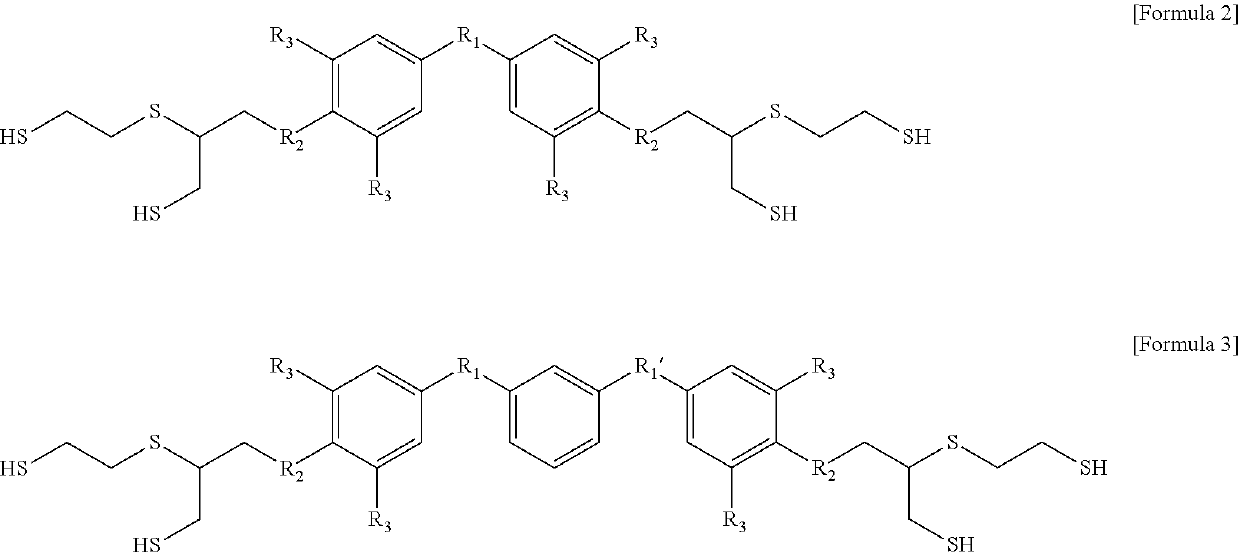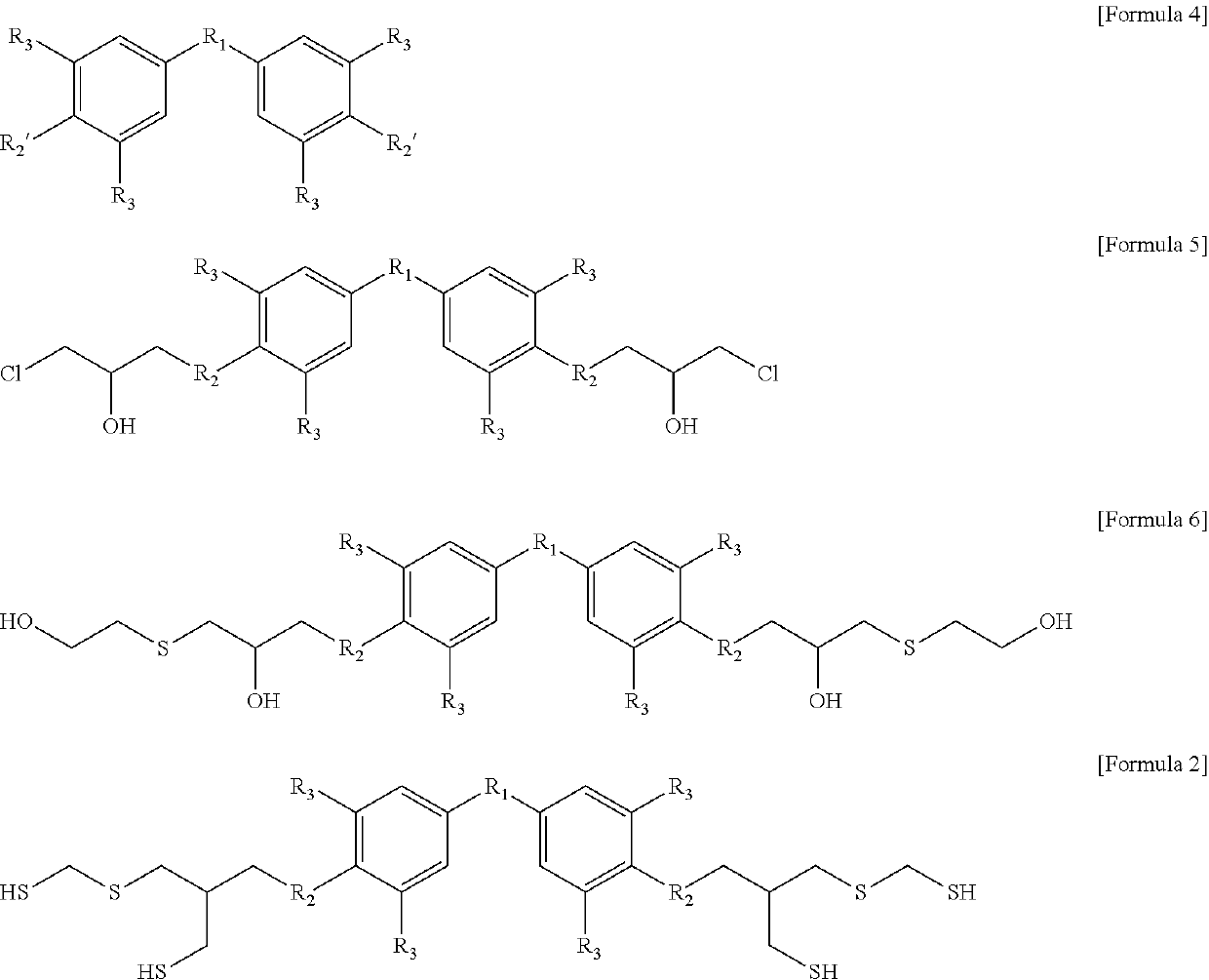Aromatic polythiol compound for optical material
a polythiol compound and optical material technology, applied in the field of aromatic polythiol compounds, can solve the problem that the refractive index of polythiourethane-based optical materials produced from this polythiol compound is not sufficient, and achieve the effects of excellent optical properties, low specific gravity, and high refractive index
- Summary
- Abstract
- Description
- Claims
- Application Information
AI Technical Summary
Benefits of technology
Problems solved by technology
Method used
Image
Examples
preparation example 1
[0151]
[0152]124.6 parts by weight of 2-mercaptoethanol and 18.3 parts by weight of distilled water were charged into a reactor, and 101.5 parts by weight of an aqueous sodium hydroxide solution (32%) were added dropwise at about 23° C. for 40 minutes. 73.6 parts by weight of epichlorohydrin were added dropwise at about 32° C. for 4.5 hours, followed by stirring the mixture for 40 minutes to obtain 2,3-bis(2-hydroxyethylthio)-1-propanol.
[0153]331.5 parts by weight of hydrochloric acid (35.5%) were added to the above compound, and 183.8 parts by weight of thiourea (99.90%) were added thereto, followed by stirring the mixture at 110° C. for 3 hours with reflux for carrying out the reaction for an isothiouronium salt. After the reaction mixture was cooled to 45° C., 320.5 parts by weight of toluene were added thereto. After the reaction mixture was cooled to 31° C., 243.1 parts by weight of an aqueous ammonia solution (25%) were added dropwise at about 36° C. for 44 minutes, followed by...
preparation example 2
[0155]
[0156]51.2 parts by weight of 2-mercaptoethanol, 26.5 parts by weight of distilled water, and 0.16 part by weight of an aqueous sodium hydroxide solution (49% by weight) were charged into a reactor, and then 61.99 parts by weight of epichlorohydrin were added dropwise at about 10° C. for 6.5 hours, followed by stirring the mixture for 60 minutes to prepare 1-chloro-3-(2-hydroxyethylthio)-2-propanol. 150 parts by weight of am aqueous sodium sulfide solution (17.3%) were added dropwise to the above compound at about 22° C. for 5.5 hours, followed by stirring the mixture for 120 minutes to obtain a reaction solution. 279 parts by weight of hydrochloric acid (35.5%) were added to the reaction solution, and then 125.8 parts by weight of thiourea were added thereto, followed by stirring the reaction solution at about 110° C. for 3 hours with reflux for carrying out the reaction for an isothiouronium salt. After the reaction mixture was cooled to 45° C., 214 parts of toluene were add...
example 1
[0159]
[0160]130 g (1 mole) of divinylbenzene, 650 g (2.5 moles) of the polythiol compound of Preparation Example 1, and 3.5 g of azobisisobutyronitrile (AIBN) were charged into a reactor and reacted at 80° C. for 5 hours. When the characteristic peak of a double bond at 1680 cm−1 in FT-IR completely disappeared, the reaction was terminated to obtain a tetrafunctional aromatic polythiol compound. The main peak of this compound in the gel permeation chromatography (GPC) analysis indicated a number average molecular weight of 1,100.
[0161]Details of the GPC analysis are shown in Table 1 below.
TABLE 1ModelWaters APC systemColumn2 Acquity APC XT Columns 45A (4.6 * 150 mm)Column temperature45° C.Mobile phaseTHFFlow rate0.5 ml / minTotal rum time10 minInjection volume10 μlDetectorRID, 40° C.
PUM
| Property | Measurement | Unit |
|---|---|---|
| refractive index | aaaaa | aaaaa |
| specific gravity | aaaaa | aaaaa |
| Tg | aaaaa | aaaaa |
Abstract
Description
Claims
Application Information
 Login to View More
Login to View More - R&D
- Intellectual Property
- Life Sciences
- Materials
- Tech Scout
- Unparalleled Data Quality
- Higher Quality Content
- 60% Fewer Hallucinations
Browse by: Latest US Patents, China's latest patents, Technical Efficacy Thesaurus, Application Domain, Technology Topic, Popular Technical Reports.
© 2025 PatSnap. All rights reserved.Legal|Privacy policy|Modern Slavery Act Transparency Statement|Sitemap|About US| Contact US: help@patsnap.com



